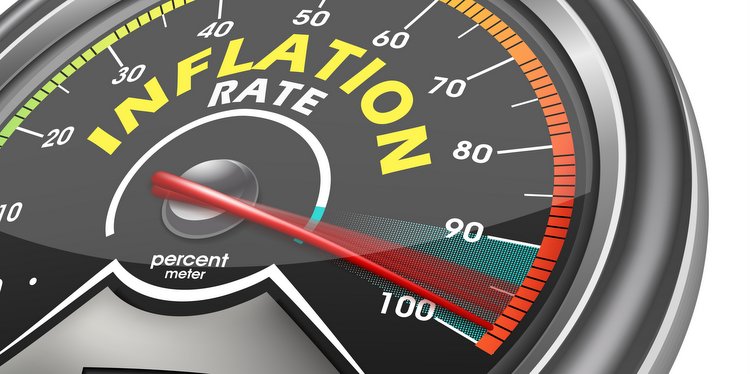Grocery Costs: Outpacing Inflation For The Third Consecutive Month

Table of Contents
The Impact of Inflation on Grocery Prices
General inflation significantly impacts the cost of food, affecting every stage from farm to table. Increased prices for energy, labor, and transportation directly translate to higher prices for the consumer. This inflationary pressure isn't evenly distributed; some grocery items have experienced far more dramatic price increases than others.
For example, the price of eggs has skyrocketed in recent months, alongside dairy products and various cuts of meat. These increases are not isolated incidents; they reflect a broader trend of escalating grocery costs.
Key inflation indicators strongly correlate with grocery costs:
- CPI (Consumer Price Index) for Food: This index tracks the average change in prices paid by urban consumers for a basket of food items. Recent data shows a steep climb in the food CPI, indicating significant price increases.
- Producer Price Index (PPI) for Agricultural Products: The PPI measures the average change in selling prices received by domestic producers for their output. A rise in the PPI for agricultural products signals increased costs for farmers, which are ultimately passed on to consumers.
- Fuel Costs: Higher fuel prices impact transportation costs across the entire food supply chain, from farm to processing plant to grocery store, leading to increased prices at the checkout.
Supply Chain Disruptions and Their Role
The lingering effects of the pandemic continue to disrupt global supply chains, significantly contributing to higher grocery prices. Labor shortages and transportation bottlenecks exacerbate the issue, leading to delays and increased costs.
Several key supply chain challenges are at play:
- Shortage of Truck Drivers and Warehouse Workers: A lack of qualified personnel slows down the movement of goods, leading to delays and increased costs.
- Increased Shipping Costs and Port Congestion: Global shipping remains expensive and unpredictable, adding to the overall cost of imported food products.
- Impact of Extreme Weather Events: Severe weather events, such as droughts and floods, can damage crops and disrupt transportation networks, resulting in reduced supply and higher prices.
The Rising Cost of Production
Farmers and food producers face significantly increased input costs, impacting their ability to keep grocery prices down. The cost of fertilizers, feed, and energy has soared, making it more expensive to produce food. These increased production costs are inevitably passed on to consumers.
Contributing factors include:
- Higher Fertilizer Prices: Geopolitical factors and supply chain issues have driven up fertilizer prices, increasing the cost of crop production.
- Increased Energy Costs: Higher energy prices increase the cost of farm operations, processing, and transportation.
- Impact of Climate Change: Climate change is impacting crop yields and livestock production, leading to reduced supply and increased prices.
Strategies for Managing Rising Grocery Costs
While the factors driving up grocery prices are largely beyond individual control, consumers can employ strategies to manage their grocery budgets more effectively. Careful planning and smart shopping habits can make a significant difference.
Actionable steps include:
- Create a Weekly Meal Plan: Planning meals in advance helps reduce food waste and ensures you buy only what you need.
- Utilize Grocery Store Apps and Websites: Many grocery stores offer digital coupons and deals that can help you save money.
- Consider Buying in Bulk (When Appropriate): Buying non-perishable items in bulk can often lead to savings, but be mindful of storage space and potential spoilage.
- Explore Cheaper Protein Sources or Substitute Ingredients: Consider using less expensive protein sources like beans or lentils, or substituting more costly ingredients with cheaper alternatives.
Conclusion: Navigating the Rising Costs of Groceries
Grocery costs continue to rise at an alarming rate, outpacing inflation for the third consecutive month. This is due to a complex interplay of inflation, supply chain issues, and increased production costs. The impact on consumers' budgets is significant, highlighting the need for both individual and systemic solutions. Understanding the factors contributing to rising grocery costs is crucial for navigating these challenging economic times. By employing smart shopping strategies and staying informed about market trends, you can better manage your grocery budget and mitigate the impact of grocery costs outpacing inflation.

Featured Posts
-
 Emploi Des Cordistes Consequence De L Urbanisation A Nantes
May 22, 2025
Emploi Des Cordistes Consequence De L Urbanisation A Nantes
May 22, 2025 -
 Ten Cau Va Duong Ket Noi Binh Duong Va Tay Ninh
May 22, 2025
Ten Cau Va Duong Ket Noi Binh Duong Va Tay Ninh
May 22, 2025 -
 Rediscovering A Classic Dennis Quaid Meg Ryan And James Caan In A Neglected Western Neo Noir
May 22, 2025
Rediscovering A Classic Dennis Quaid Meg Ryan And James Caan In A Neglected Western Neo Noir
May 22, 2025 -
 Linsi Grem Zaklikaye Vidnoviti Viyskovu Dopomogu Ukrayini Pozitsiya S Sh A Ta Reaktsiya Rosiyi
May 22, 2025
Linsi Grem Zaklikaye Vidnoviti Viyskovu Dopomogu Ukrayini Pozitsiya S Sh A Ta Reaktsiya Rosiyi
May 22, 2025 -
 Musique En Live Le Hellfest Au Noumatrouff
May 22, 2025
Musique En Live Le Hellfest Au Noumatrouff
May 22, 2025
